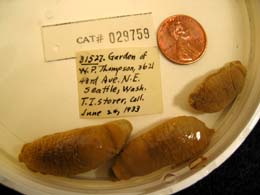On June 24, 1933, California naturalist Tracey Storer collects several slugs from a yard in the Seattle neighborhood of Laurelhurst. He then transports them to the California Academy of Sciences where they are identified as Arion ater, a non-native slug. Storer’s slugs are the first known specimens of this European native ever found in the western United States. Arion ater, later renamed Arion rufus, is the best known and probably most despised slug found in urban gardens, where they often ravage vegetables, ornamentals, and other green growing things.
Notorious Beast Discovered
The white, two-story house looks like many others in the tony Seattle neighborhood of Laurelhurst: understated and elegant with a well-taken care of yard. Few who walk by would guess that notorious beasts dwelt there, until June 24, 1933, when California naturalist Tracey Storer catches them and takes them south. The three critters currently float in a jar of ethanol at the California Academy of Sciences. Storer’s animals are several-inch-long slugs, known scientifically as Arion rufus.
For those who now inhabit Seattle, or nearly any city between Arcata, California, and Vancouver, BC, finding an Arion rufus in their yards would not prompt them to collect it, take it to California, to a leading scientific institute, label it, and preserve it for posterity. Most people would probably kill it on the spot, or, if they were feeling generous, they might scoop up the offending gastropod and transfer it out of their yards. The difference between now and then is that modern urbanites see Arion rufus, commonly called the European, red, or black slug, as a slimy, good-for-nothing garden despoiler.
In contrast, Storer saw the slug as an unusual specimen, singular in its appearance in Seattle. The one he collected is the first known specimen of this European native ever found in the Western United States although French malacologist Jean Grateloup claimed in 1855 to have one from the “Western States.”
A Striking and Beautiful Object?
First discovered in this country in Detroit in 1912 and described as “a striking and beautiful object,” Arion rufus did not thrive on the East Coast (Walker, 2). (Early collectors misidentified Arion rufus as Arion ater, another European native. They are notoriously hard to tell apart; both can be reddish or black. Malacologists separate them based on genitalia, mating habits, and season of maturity.) Red slugs do not do well in the cold but the slipperly little invertebrates found near perfect conditions in the temperate, wet Pacific Northwest. From lowly beginnings in a well-manicured yard on 43rd Avenue NE, Arion rufus became a pest in Seattle by 1940 and reached Oregon in 1942, Vancouver, B.C. in 1945, and California in 1954.
Where it has invaded, Arion rufus can become rampant. In Crescent City, a homeowner once claimed to have killed over 5,000 slugs in one month and in Washington state, Arion rufus and two other slugs have damaged as much as 75 percent of the first strawberry crop. In response, people have declared an all out battle, relying on such slug-killing toxics as Deadline Force, Sluggo, and Escar-Go!. Less toxic methods include beer traps, copper strips, egg shells, blendered-slug juice, and nematodes (microscopic worms.)
To Kill or To Be Kind
Nematodes that parasatize only slugs, are becoming more popular because they are safe to use around children and other pets. The use of the wee worms still faces the main challenge of other methods: there are so many slugs that you cannot get them all.
Not everyone, however, is so quick to rise up against slugs. Back in Seattle, after hearing about the infamous slug collected by Tracey Storer, the home’s present owner, a gardener, says, “I guess I will have to be kindler and gentler to them.”

